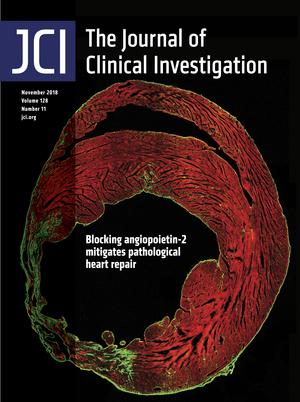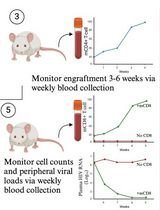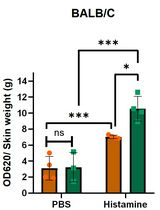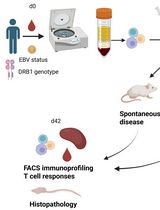- EN - English
- CN - 中文
Early Life Ovalbumin Sensitization and Aerosol Challenge for the Induction of Allergic Airway Inflammation in a BALB/c Murine Model
BALB/c小鼠模型中早期卵白蛋白致敏和气溶胶攻击诱导的过敏性气道炎症
发布: 2019年03月05日第9卷第5期 DOI: 10.21769/BioProtoc.3181 浏览次数: 6417
评审: Gal HaimovichLaura CampisiMarieta Ruseva
Abstract
The early life period represents a time of immunological plasticity whereby the functionally immature immune system is highly susceptible to environmental stimulation. Perennial aeroallergen and respiratory viral infection induced sporadic episodes of lung inflammation during this temporal window represent major risk factors for initiation of allergic asthmatic disease. Murine models are widely used as an investigative tool to examine the pathophysiology of allergic asthma; however, models in current usage typically do not encapsulate the early life period which represents the time of maximal risk for disease inception in humans. To address this issue, this protocol adapted an experimental animal model of disease for sensitization to ovalbumin during the immediate post-weaning period beginning at 21 days of age. By initially sensitizing mice during this early life post-weaning period, researchers can more closely align experimental allergic airway disease models with the human age group most at risk for asthma development.
Keywords: Asthma (哮喘)Background
Allergic asthma is a highly heterogeneous and complex inflammatory disease of the airways, with current estimates indicating over 350 million individuals worldwide are affected (Masoli et al., 2004; Soriano et al., 2017). The classical hallmark features of the disease include elevated antigen-specific serum immunoglobulin E, CD4+ T-helper (Th) type 2-driven eosinophilic inflammation and reversible airways hyperresponsiveness to innocuous environmental antigens (Bousquet et al., 2000; Holgate, 2008).
Allergic asthma is recognized as a developmental disease with its inception now acknowledged to occur most commonly during the early stages of postnatal development. During this period, the inability of the functionally immature immune system to mount an efficient response to innocuous perennial aeroallergen exposure and respiratory viral infection leads to periods of exaggerated/dysregulated airways inflammation (Johnston et al., 1995; Holt et al., 2005; Jackson et al., 2016). This persistent inflammatory state within the airways can lead to loss of function and in concert with atopic sensitization during this time of immunological plasticity, promote the eventual onset of an established asthmatic phenotype during childhood (Holt et al., 2005; Jackson et al., 2016).
To elucidate the cellular and molecular mechanisms driving disease pathogenesis, murine models of experimental allergic airway disease are frequently employed (Kumar et al., 2016). It has been well established that initial sensitization at 8 weeks of age with the model antigen ovalbumin (OVA), followed by antigen challenge results in Th2-polarized airways disease, mimicking key essential clinical manifestations of human disease (von Garnier et al., 2007; Zosky et al., 2008). While 8-week-old sensitization models have provided significant advances in our understanding of asthmatic disease pathogenesis, they are not the best representative model for early life sensitization as mice attain sexual maturity at 8-12 weeks of age (Dutta and Sengupta, 2016). To address this age-dependent issue associated with murine models of allergic airway disease, this protocol sensitizes Th2-bias BALB/c mice during the early post-weanling period, paralleling that of early human childhood (Dutta and Sengupta, 2016). In brief, juvenile BALB/c mice are intraperitoneally sensitized to OVA at 21 and 35 days of age, followed by 3 consecutive OVA aerosol challenges on days 42-44 of age, with autopsy 24 h post final aerosol.
Materials and Reagents
- 1.5 ml screw cap micro tube (SARSTEDT, catalog number: 72.703.600)
- 5 ml screw cap tube (SARSTEDT, catalog number: 60.9921.524)
- 25 ml screw cap tube (SARSTEDT, catalog number: 60.9922.243)
- 27 G x ½” 1 ml Insulin syringe (Terumo, catalog number: SS*10M2713A)
- Aluminum foil
- 500 ml Bottle Top Filter, 0.2 µm pore size (Thermo Fisher Scientific, Nalgene® Rapid-FlowTM, catalog number: 595-4520)
- 50 ml serological pipette (SARSTEDT, catalog number: 86.1256.001)
- 21-day-old BALB/c mice (Animal Resource Centre, Murdoch, Australia)
Notes:- All mice were fed an OVA free diet.
- Both male and female mice were used.
- n ≥ 6 mice per experiment.
- All mice were fed an OVA free diet.
- Ovalbumin lyophilized powder (Sigma-Aldrich, catalog number: A5503, store at 4 °C)
- Aluminum hydroxide (SERVA, catalog number: 12261.02, store at room temperature in the dark)
- Sterile Water for Irrigation (Baxter, catalog number: 2F7113, store at room temperature)
- Sodium chloride (NaCl) (Rowe Scientific, catalog number: CS10363)
- Potassium chloride (KCl) (Rowe Scientific, catalog number: CP2600)
- Sodium phosphate dibasic anhydrous (Na2HPO4) (Sigma-Aldrich, catalog number: RES20908-A704X)
- Potassium phosphate monobasic anhydrous (KH2PO4) (Amresco, catalog number: 97062-350)
- Hydrochloric acid (HCl) (Sigma-Aldrich, catalog number: 320331-500ML)
- Sterile phosphate buffered saline (PBS) (see Recipes)
- 1 mg/ml ovalbumin stock solution (see Recipes)
- 10 mg/ml ovalbumin stock solution (see Recipes)
- Ovalbumin-aluminum hydroxide (OVA-Alum) preparation for one mouse (see Recipes)
Equipment
- Housing cages (Tecniplast, GM500)
- 500 ml measuring cylinder (Rowe Scientific, catalog number: GC1276)
- 100 ml Schott bottle (Sigma-Aldrich, Duran®, catalog number: Z305170)
- 500 ml Schott bottle (Sigma-Aldrich, Duran®, catalog number: Z305197)
- 5,000 ml Schott bottle (Sigma-Aldrich, Duran®, catalog number: Z305227)
- 5,000 ml volumetric flask (Sigma-Aldrich, Duran®, catalog number: 246787355)
- S1 Pipet Filler (Thermo Fisher Scientific, Thermo ScientificTM, catalog number: 9521)
- Rotary suspension mixer (Ratek, catalog number: RSM7DC)
- Ultrasonic nebulizer (DeVilbiss Healthcare, UltraNeb, catalog number: U3000)
- 25 cm x 40 cm plexiglass aerosol chamber (AFM Plastics)
- -20 °C freezer
Software
- GraphPad Prism (GraphPad software, version 7.0a)
Procedure
文章信息
版权信息
© 2019 The Authors; exclusive licensee Bio-protocol LLC.
如何引用
Mincham, K. T., Scott, N. M., Lauzon-Joset, J., Leffler, J., Stumbles, P. A., Holt, P. G. and Strickland, D. H. (2019). Early Life Ovalbumin Sensitization and Aerosol Challenge for the Induction of Allergic Airway Inflammation in a BALB/c Murine Model. Bio-protocol 9(5): e3181. DOI: 10.21769/BioProtoc.3181.
分类
免疫学 > 动物模型 > 小鼠
免疫学 > 炎症性疾病 > 过敏症
您对这篇实验方法有问题吗?
在此处发布您的问题,我们将邀请本文作者来回答。同时,我们会将您的问题发布到Bio-protocol Exchange,以便寻求社区成员的帮助。
Share
Bluesky
X
Copy link














